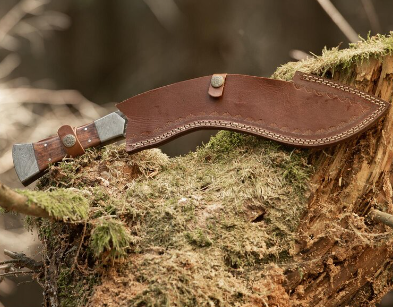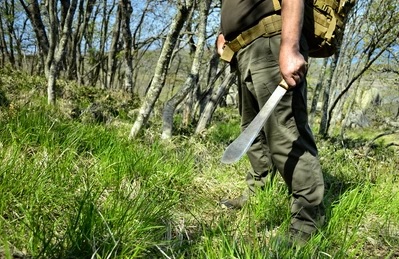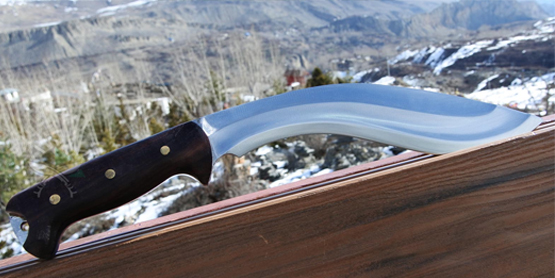How to Clean a Rusty Machete? DIY Machete Restoration
It’s crucial to take certain safety precautions before cleaning your rusted machete. Rusty metal can be sharp and may contain toxic chemicals or bacteria. Therefore it’s vital to use protective gloves and eye goggles to safeguard yourself from any potential damage.
A step-by-step tutorial for cleaning a rusty machete is provided below:
Supplies Required
- A Container or Bucket ig enough to accommodate the Machete
- Sandpaper or Steel Wool
- A Toothbrush or Wire Brush
- Vinegar or Rust Remover
- Oil or Lubricant
- Safety Gloves
Steps to clean a rusty machete
Table of Contents
Preparing the Machete
Preparing your machete should be your first step. If the handle of your machete is made of wood, you should use plastic wrap or tape to keep it dry. Moreover, to keep your machete from sliding while you clean, keep it firmly clamped down or held in place.
Removing the Rust
You’ll need to use some abrasives, such as sandpaper, steel wool, or a wire brush, to remove the rust from your machete. These substances will aid in removing rust and bringing back the metal’s sheen.
To start, sand any sizable rust areas with steel wool or coarse-grit sandpaper. Apply continuous pressure as gently brush the abrasive substance over the rusted spots. You might need to use additional force or a more abrasive material for rust spots that are very difficult to remove.
After that, polish the metal’s surface and eliminate any leftover rust by switching to fine-grit sandpaper or steel wool. Also, by doing this, the metal will be better ready for applying a rust remover in the following phase.
Applying Rust Remover
It’s time to use a rust remover after eliminating as much rust as possible. Chemicals in rust removers break down rust and stop it from developing again. Rust removers are available online and at the majority of hardware stores.
Apply the rust remover to your machete according to the manufacturer’s instructions. Usually, you’ll need to spray the rust remover on the troublesome regions and give it a few minutes to work. After that, remove any remaining rust dissolver and rust using a clean towel.
Drying Machete
Your machete must be thoroughly dried to stop fresh rust from forming after using a rust remover. Wipe any extra rust remover and moisture using a clean, dry towel. To move on to the next step, ensure the machete is dry.
Oiling is Essential
Apply a thin layer of lubricants like oil or wax to prevent corrosion on your machete. You can use a variety of lubricants, such as mineral oil, vegetable oil, and gun oil.
Apply the lubricant evenly to the whole surface of the machete with a clean cloth. Keep a close eye on the handle, blade, and other challenging-to-reach regions.
How to Store the Machete to Prevent Rust Build-Up?
After lubricating and cleaning your machete, store it correctly to avoid rust. Keep it free from moisture and direct sunshine in a dry, cold location.
Consider wrapping your machete in a cloth or newspaper to keep dust and other debris off it if you intend to preserve it for a long time.
What To Do If Rust Has Penetrated Deep?
You might be interested in utilizing phosphoric acid if severe pitting and deep corrosion occur. It is available in gallon containers. It will safely and effectively remove rust from your steel and cast iron tools, tables, and bits. Some older people still use it to “sharpen” files. It serves as the primary component of the parkerizing solution.
Remove the majority of the loose rust first. You might want to scratch or rub some of it based on its damage. Alternatively, you might simply clean it with an oiled cloth. After that, use a solvent to degrease the blade. Either remove the scales from the handle or tape a plastic bag over it. After that, leave the knife in the acid for a few hours in the appropriate container.
After rinsing, apply oil and wipe down. A black patina will take the place of the scarlet rust. You can even get some black patina over other areas of the blade if you leave it in there long enough. This won’t harm the blade, but if it bothers you, you can remove it using steel wool or sandpaper.
Any acid will dissolve rust, and it will also very slowly eat away at the steel’s surface, although these effects are rather self-limiting. Acids will consume rust considerably more quickly than the rest of the blade since they can only react with oxidized steel. Lemon juice or vinegar are two other options. That will take considerably longer, though.
Do NOT use hydrochloric or muriatic acid to remove rust from steel. It will work flawlessly, but the chlorine will ingest the steel and cause it to rust again. Swiftly and poorly. In addition, it may lead to hydrogen embrittlement.
Phosphoric acid is also available as a gel, which is perhaps more practical. You can buy it in smaller containers under the trade name Navy Jelly.
How to Remove Rust From Machete Using Vinegar?
You can use the vinegar method as described above or use the following method to clean the rusty blade.
You can sprinkle the salt on the blades and let them sit for a few minutes. After that cut the lemon and start rubbing it on the surface. The acid in the lemon will react will salt and extract all the rust from the blade. Now rinse the blade with warm water and clean it with a dry cloth. Be careful don’t let the lemon juice be on the bade for more than a few minutes as it may damage the blade.
The second method is the use of baking soda. Take the bowl of baking soda and add a little water to make the paste. Now apply this paste to the blade and let it sit for two to three hours. Make sure the paste is thick enough to stay on and get dried like the lumps.
After that scratch all the paste with the help of the steel wool. Now rise in under the water to remove all the spots. After that dry the blade with a clean cloth and be done. Apply the layer of oil to prevent corrosion in the future.
How to Unrust a Machete?
It is very simple to Unrust the blade. You have to keep it in the bowl of vinegar for 24 hours. The acid in the vinegar will extract all the iron particles from the blade and make it clear.
Then use the steel wool or sandpaper and rub it on the blade in order to remove the remaining particle. In the end, wash the blade thoroughly with water.
Let it sit so that it gets completely dried. In the end, apply the layer of olive or linseed oil and place it inside the sheath.
How To Clean Your Blade?
Cleaning the blade is not a difficult task. You first have to understand the nature of the blade and then use a particular cleaning agent to clean the blade. For all three types which are stainless steel, carbon steel, or carbon stainless steel you can use vinegar to clean the surface. To remove the corrosion, use the steel wool dipped in the vinegar and then remove the rust spots from the machete.
Final Words
A rusty machete may be cleaned quickly with inexpensive supplies and tools. Yet it’s crucial to practice safety measures, such as donning safety gear and being cautious while handling sharp objects. Your machete’s lifespan will be increased and kept in excellent condition with routine cleaning and maintenance. Be sure to clean your blade after every use and try to make a habit out of it. In addition, store it in a cool place where there aren’t many temperature fluctuations, and ensure the place isn’t damp to avoid rusting your machete again.
Frequently Asked Questions (FAQs)
- What Causes Machete Rust?
A chemical reaction between the metal of the machete blade and oxygen in the air in the presence of moisture causes machete rust.
- Can Machete Rust be Harmful?
Machete rust can compromise the blade’s integrity, making it weaker and potentially more dangerous.
- What Kind of Oil Should I use to Prevent Machete Rust?
A high-quality mineral oil or gun oil can be used to prevent machete rust. Apply a thin layer of oil to the blade and wipe off any excess.







